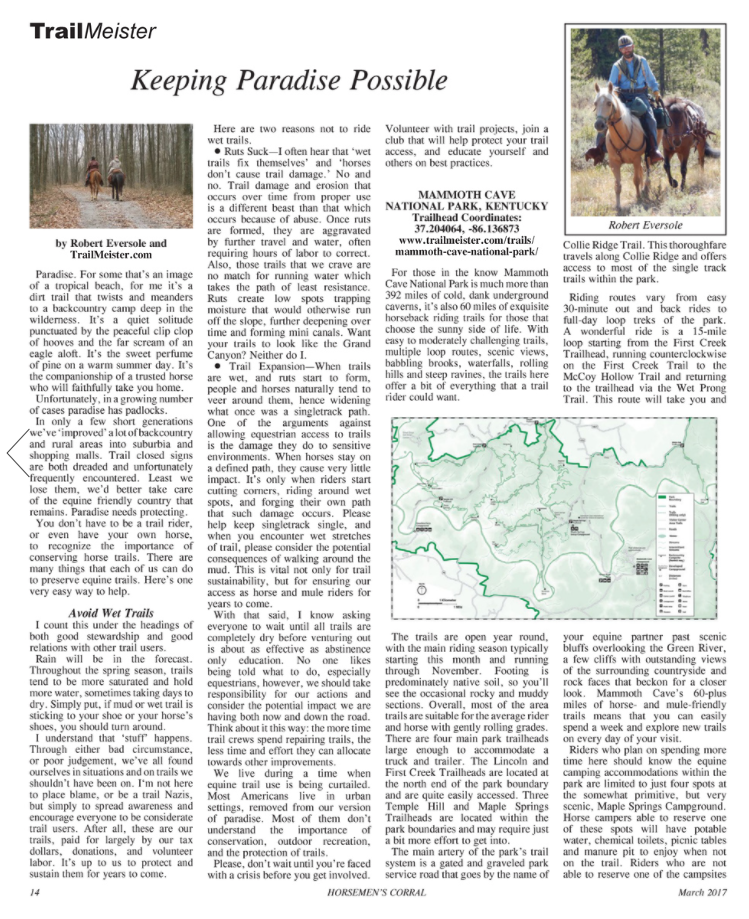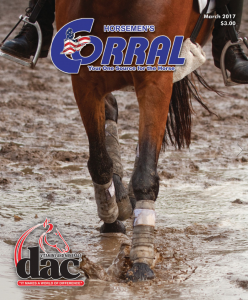 Keeping Trails Open and Riding Mammoth Cave
Keeping Trails Open and Riding Mammoth Cave
As Published in the Mar 2017 issue of Horsemen’s Corral
Keeping Paradise Possible
Paradise. For some that’s an image of a tropical beach, for me it’s a dirt trail that twists and meanders to a backcountry camp deep in the wilderness. It’s a quiet solitude punctuated by the peaceful clip clop of hooves and the far scream of an eagle aloft. It’s the sweet perfume of pine on a warm summer day. It’s the companionship of a trusted horse who will faithfully take you home.
Unfortunately, in a growing number of cases paradise has padlocks.
In only a few short generations we’ve “improved” a lot of backcountry and rural areas into suburbia and shopping malls. Trail Closed signs are both dreaded and unfortunately frequently encountered. Least we lose them, we’d better take care of the equine friendly country that remains. Paradise needs protecting.
You don’t have to be a trail rider, or even have your own horse, to recognize the importance of conserving horse trails. There are many things that each of us can do to preserve equine trails. Here’s one very easy way to help.
Avoid Wet Trails
I count this under the headings of both good stewardship and good relations with other trail users.
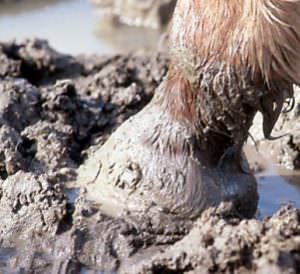 Rain will be in the forecast. Throughout the spring season, trails tend to be more saturated and hold more water, sometimes taking days to dry. Simply put, if mud or wet trail is sticking to your shoe or your horse’s shoes, you should turn around.
Rain will be in the forecast. Throughout the spring season, trails tend to be more saturated and hold more water, sometimes taking days to dry. Simply put, if mud or wet trail is sticking to your shoe or your horse’s shoes, you should turn around.
I understand that “stuff” happens. Through either bad circumstance, or poor judgement, we’ve all found ourselves in situations and on trails we shouldn’t have been on. I‘m not here to place blame, or be a trail Nazis, but simply to spread awareness and encourage everyone to be considerate trail users. After all, these are our trails, paid for largely by our tax dollars, donations, and volunteer labor. It’s up to us to protect and sustain them for years to come.
Here are two reasons not to ride wet trails.
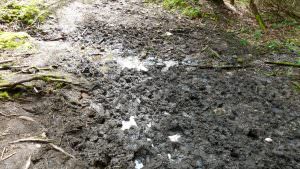 Ruts Suck – I often hear that “wet trails fix themselves” and “horses don’t cause trail damage.” No and no. Trail damage and erosion that occurs over time from proper use is a different beast than that which occurs because of abuse. Once ruts are formed, they are aggravated by further travel and water, often requiring hours of labor to correct. Also, those trails that we crave are no match for running water which takes the path of least resistance. Ruts create low spots trapping moisture that would otherwise run off the slope, further deepening over time and forming mini canals. Want your trails to look like the Grand Canyon? Neither do I.
Ruts Suck – I often hear that “wet trails fix themselves” and “horses don’t cause trail damage.” No and no. Trail damage and erosion that occurs over time from proper use is a different beast than that which occurs because of abuse. Once ruts are formed, they are aggravated by further travel and water, often requiring hours of labor to correct. Also, those trails that we crave are no match for running water which takes the path of least resistance. Ruts create low spots trapping moisture that would otherwise run off the slope, further deepening over time and forming mini canals. Want your trails to look like the Grand Canyon? Neither do I.
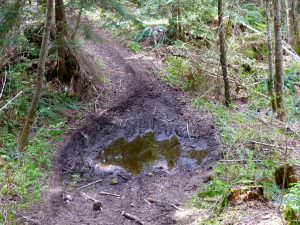 Trail Expansion – When trails are wet, and ruts start to form, people and horses naturally tend to veer around them, hence widening what once was a singletrack path. One of the arguments against allowing equestrian access to trails is the damage they do to sensitive environments. When horses stay on a defined path, they cause very little impact. It’s only when riders start cutting corners, riding around wet spots, and forging their own path that such damage occurs. Please help keep singletrack single, and when you encounter wet stretches of trail, please consider the potential consequences of walking around the mud. This is vital not only for trail sustainability, but for ensuring our access as horse and mule riders for years to come.
Trail Expansion – When trails are wet, and ruts start to form, people and horses naturally tend to veer around them, hence widening what once was a singletrack path. One of the arguments against allowing equestrian access to trails is the damage they do to sensitive environments. When horses stay on a defined path, they cause very little impact. It’s only when riders start cutting corners, riding around wet spots, and forging their own path that such damage occurs. Please help keep singletrack single, and when you encounter wet stretches of trail, please consider the potential consequences of walking around the mud. This is vital not only for trail sustainability, but for ensuring our access as horse and mule riders for years to come.
With that said, I know asking everyone to wait until all trails are completely dry before venturing out is about as effective as abstinence only education. No one likes being told what to do, especially equestrians, however, we should take responsibility for our actions and consider the potential impact we are having both now and down the road. Think about it this way: the more time trail crews spend repairing trails, the less time and effort they can allocate towards other improvements.
We live during a time when equine trail use is being curtailed. Most Americans live in urban settings, removed from our version of paradise. Most of them don’t understand the importance of conservation, outdoor recreation, and the protection of trails.
Please, don’t wait until you’re faced with a crisis before you get involved. Volunteer with trail projects, join a club that will help protect your trail access, and educate yourself and others on best practices.
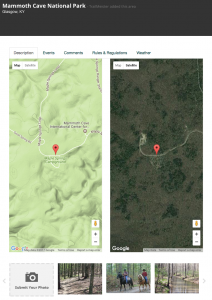 Mammoth Cave National Park, Kentucky
Mammoth Cave National Park, Kentucky
Trailhead Coordinates: 37.204064, -86.136873
On the web: https://www.trailmeister.com/trails/mammoth-cave-national-park/
For those in the know Mammoth Cave National Park is much more than 392 miles of cold, dank underground caverns, it’s also 60 miles of exquisite horseback riding trails for those that choose the sunny side of life. With easy to moderately challenging trails, multiple loop routes, scenic views, babbling brooks, waterfalls, rolling hills and steep ravines, the trails here offer a bit of everything that a trail rider could want.
The trails are open year round, with the main riding season typically starting his month and running through November. Footing is predominately native soil, so you’ll see the occasional rocky and muddy sections. Overall, most of the area trails are suitable for the average rider and horse with gently rolling grades. There are four main park trailheads large enough to accommodate a truck and trailer. The Lincoln and First Creek Trailheads are located at the north end of the park boundary and are quite easily accessed. Three Temple Hill and Maple Springs Trailheads are located within the park boundaries and may require just a bit more effort to get into.
The main artery of the park’s trail system is a gated and graveled park service road that goes by the name of Collie Ridge Trail. is thoroughfare travels along Collie Ridge and offers access to most of the single track trails within the park.
Riding routes vary from easy 30-minute out and back rides to full-day loop treks of the park. A wonderful ride is a 15-mile loop starting from the First Creek Trailhead, running counterclockwise on the First Creek Trail to the McCoy Hollow Trail and returning to the trailhead via the Wet Prong Trail. This route will take you and your equine partner past scenic bluffs overlooking the Green River, a few cliffs with outstanding views of the surrounding countryside and rock faces that beckon for a closer look. Mammoth Cave’s 60-plus miles of horse- and mule-friendly trails means that you can easily spend a week and explore new trails on every day of your visit.
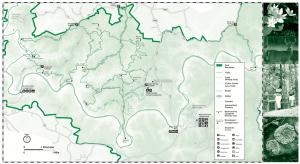 Riders who plan on spending more time here should know the equine camping accommodations within the park are limited to just four spots at the somewhat primitive, but very scenic, Maple Springs Campground. Horse campers able to reserve one of these spots will have potable water, chemical toilets, picnic tables and manure pit to enjoy when not on the trail. Riders who are not able to reserve one of the campsites within the park or who just want a bit more luxury have the option of staying at one of the several private horse camping facilities located just outside the park that offer many more camping spots as well as showers, hot water and covered stalls.
Riders who plan on spending more time here should know the equine camping accommodations within the park are limited to just four spots at the somewhat primitive, but very scenic, Maple Springs Campground. Horse campers able to reserve one of these spots will have potable water, chemical toilets, picnic tables and manure pit to enjoy when not on the trail. Riders who are not able to reserve one of the campsites within the park or who just want a bit more luxury have the option of staying at one of the several private horse camping facilities located just outside the park that offer many more camping spots as well as showers, hot water and covered stalls.
Any discussion of Mammoth Cave National Park’s equestrian side would be incomplete without a mention of the Mammoth Cave Back Country Horsemen. A group of volunteer riders who work to help keep the Park trails in good condition and open to equestrian usage.


